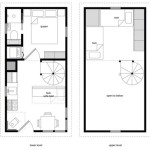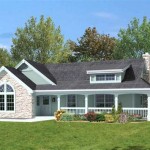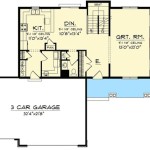A house layout plan, or floor plan, is a blueprint or diagram that depicts the arrangement of rooms and spaces within a house. It provides a detailed overview of the house’s interior design, including the placement of walls, doors, windows, and other architectural features. Floor plans are essential for planning and constructing new homes, as well as remodeling existing ones. They guide architects, engineers, and builders in visualizing and creating functional and aesthetically pleasing living spaces.
House layout plans are not just limited to new construction projects. They can also be used for renovations, additions, or simply rearranging furniture. By referring to a floor plan, homeowners and interior designers can plan and coordinate changes to improve the flow and functionality of their living spaces. They can experiment with different layouts, identify potential problems, and ensure that the final design meets their needs and preferences.
In the following sections, we will delve deeper into the benefits and components of house layout plans, exploring the different types and their advantages and disadvantages. We will also provide tips and guidance on creating efficient and comfortable floor plans that enhance the overall livability and enjoyment of a home.
Here are nine important points to consider when creating a house layout plan:
- Functionality: Design a layout that meets your lifestyle and needs.
- Flow: Ensure a smooth and logical flow between rooms.
- Privacy: Consider the placement of private and public spaces.
- Natural light: Maximize natural light throughout the house.
- Energy efficiency: Plan for energy-efficient features, such as passive solar design.
- Storage: Include adequate storage space throughout the house.
- Accessibility: Ensure the layout is accessible for all users.
- Scalability: Consider future needs and the potential for expansion.
- Aesthetics: Create a layout that is not only functional but also visually appealing.
By considering these points, you can create a house layout plan that meets your specific requirements and enhances the overall livability and enjoyment of your home.
Functionality: Design a layout that meets your lifestyle and needs.
The functionality of a house layout plan refers to how well the layout meets the specific needs and lifestyle of the occupants. A well-designed layout should provide a comfortable and efficient living environment that supports the daily activities and routines of the household. Here are some key considerations for designing a functional house layout plan:
1. Identify your needs: Start by identifying your current and future needs. Consider the number of people living in the house, their ages, and their individual requirements. Think about how you use your home on a daily basis, and what activities are most important to you. Do you need a home office? A large kitchen for entertaining? A dedicated playroom for children? Once you have a clear understanding of your needs, you can start to design a layout that accommodates them.
2. Plan for flow and efficiency: The flow of a house layout refers to the way people move through the space. A good layout should allow for smooth and efficient movement between rooms, without any unnecessary obstacles or bottlenecks. Consider the placement of doors and windows, and how they affect the flow of traffic. You should also think about the proximity of different rooms, and how they relate to each other. For example, the kitchen should be easily accessible from the dining room and living room, and the bedrooms should be located away from high-traffic areas.
3. Create distinct zones: Divide your house into different zones based on their function. For example, you might have a public zone for entertaining guests, a private zone for bedrooms and bathrooms, and a service zone for the kitchen, laundry room, and garage. Zoning helps to create a more organized and efficient layout, and it can also help to reduce noise and clutter.
Flow: Ensure a smooth and logical flow between rooms.
The flow of a house layout plan refers to the way people move through the space. A good layout should allow for smooth and efficient movement between rooms, without any unnecessary obstacles or bottlenecks. Consider the placement of doors and windows, and how they affect the flow of traffic. You should also think about the proximity of different rooms, and how they relate to each other. For example, the kitchen should be easily accessible from the dining room and living room, and the bedrooms should be located away from high-traffic areas.
One way to improve the flow of your house is to create a central circulation space, such as a hallway or foyer. This space can serve as a hub that connects different parts of the house, and it can help to reduce congestion in other areas. You should also avoid creating dead-end spaces, which can make it difficult to move around the house. Instead, try to create a circular flow pattern, so that people can move easily from one room to another without having to backtrack.
Another important consideration is the placement of doors and windows. Doors should be placed in a way that minimizes disruption to the flow of traffic, and they should be wide enough to allow for easy movement of furniture and other objects. Windows should be placed to provide natural light and ventilation, and they should be located in a way that does not compromise the privacy of the occupants.
By carefully considering the flow of your house layout plan, you can create a home that is both comfortable and efficient. A well-designed layout will allow you to move around your home easily and effortlessly, and it will make your daily activities more enjoyable.
Privacy: Consider the placement of private and public spaces.
Privacy is an important consideration in any house layout plan. You want to create a home that is both comfortable and inviting, but you also want to ensure that each member of the household has their own private space. Here are some key considerations for placing private and public spaces in your house layout plan:
1. Identify your private and public spaces: The first step is to identify which spaces in your home need to be private and which can be public. Private spaces are typically used for sleeping, bathing, and other activities that require privacy. Public spaces are typically used for entertaining guests, cooking, and other activities that are shared with others. Once you have identified your private and public spaces, you can start to plan their placement.
2. Place private spaces away from public spaces: As a general rule, private spaces should be placed away from public spaces. This will help to reduce noise and disturbance from public areas, and it will also give occupants of private spaces more privacy. For example, you might place the bedrooms on the second floor of your house, away from the living room and kitchen. You might also place the master bedroom in a secluded corner of the house, away from the other bedrooms.
3. Create buffer zones between private and public spaces: If you have to place private and public spaces near each other, you can create buffer zones to help reduce noise and disturbance. For example, you might place a hallway or mudroom between the kitchen and the living room. You might also place a dressing room or walk-in closet between the master bedroom and the master bathroom.
4. Consider the placement of windows and doors: The placement of windows and doors can also affect privacy. For example, you might want to avoid placing windows in private spaces that are directly visible from public areas. You might also want to place doors in private spaces so that they are not directly visible from public areas.
Natural light: Maximize natural light throughout the house.
Natural light is essential for creating a healthy and inviting home. It can improve your mood, boost your energy levels, and help you sleep better at night. When designing your house layout plan, it is important to consider how you can maximize natural light throughout the house.
Here are some tips for maximizing natural light in your house layout plan:
- Place windows and doors strategically: The placement of windows and doors is critical for maximizing natural light. Try to place windows and doors on the south side of your house, which receives the most sunlight. You should also consider the size and shape of your windows and doors. Larger windows and doors will allow more light into your home.
- Use skylights and solar tubes: Skylights and solar tubes are a great way to bring natural light into dark areas of your home, such as hallways, bathrooms, and closets. Skylights are installed in the roof of your house, while solar tubes are installed in the ceiling. Both skylights and solar tubes can provide a significant amount of natural light, even on cloudy days.
- Choose light-colored finishes: Light-colored finishes, such as white, cream, and beige, reflect more light than dark-colored finishes. This can help to brighten up your home and make it feel more spacious. You can use light-colored finishes on your walls, ceilings, floors, and furniture.
- Avoid blocking windows: When placing furniture and other objects in your home, be careful not to block windows. This will reduce the amount of natural light that enters your home. Instead, try to place furniture and objects in a way that allows natural light to flow freely throughout your home.
By following these tips, you can create a house layout plan that maximizes natural light throughout your home. This will create a more healthy, inviting, and enjoyable living environment for you and your family.
Energy efficiency: Plan for energy-efficient features, such as passive solar design.
Energy efficiency is an important consideration in any house layout plan. By incorporating energy-efficient features into your home, you can reduce your energy consumption and save money on your utility bills. One of the most effective ways to improve the energy efficiency of your home is to use passive solar design.
Passive solar design is a set of design principles that use the sun’s energy to heat and cool your home naturally. By carefully positioning windows, doors, and other building elements, you can create a home that takes advantage of the sun’s warmth in the winter and sheds the sun’s heat in the summer. This can significantly reduce your reliance on heating and cooling systems, and it can help you to create a more comfortable and energy-efficient home.
Here are some key principles of passive solar design:
- Orientation: The orientation of your home is critical for passive solar design. In the Northern Hemisphere, south-facing windows will receive the most sunlight. This is the ideal orientation for your living spaces, such as your living room, dining room, and kitchen. Bedrooms can be oriented to the east or west to take advantage of the morning or afternoon sun.
- Window placement: The placement of windows is also important for passive solar design. Windows should be placed high on the walls to allow sunlight to penetrate deep into your home. Overhangs can be used to shade windows in the summer and allow sunlight to enter in the winter.
- Thermal mass: Thermal mass is the ability of a material to absorb and store heat. Materials with high thermal mass, such as concrete, brick, and tile, can help to regulate the temperature of your home. By incorporating thermal mass into your home, you can reduce temperature fluctuations and improve your energy efficiency.
Passive solar design is a cost-effective way to improve the energy efficiency of your home. By following these principles, you can create a home that is more comfortable, more energy-efficient, and more sustainable.
In addition to passive solar design, there are a number of other energy-efficient features that you can incorporate into your house layout plan. These features include:
- Energy-efficient appliances: When choosing appliances, look for models that have the Energy Star label. Energy Star appliances meet strict energy efficiency standards, and they can help you to save money on your energy bills.
- LED lighting: LED lighting is much more energy-efficient than traditional incandescent lighting. By switching to LED lighting, you can reduce your energy consumption and save money on your utility bills.
- Solar panels: Solar panels can be used to generate electricity from the sun. By installing solar panels on your home, you can reduce your reliance on the grid and save money on your energy bills.
By incorporating these energy-efficient features into your house layout plan, you can create a home that is more comfortable, more energy-efficient, and more sustainable.
Storage: Include adequate storage space throughout the house.
Adequate storage space is essential for any home. It helps to keep your belongings organized and out of sight, and it can also help to improve the overall flow and functionality of your home. When designing your house layout plan, be sure to include adequate storage space throughout the house, in both public and private areas.
- Closets: Closets are a great way to store clothes, shoes, and other belongings. Be sure to include closets in all bedrooms, as well as in other areas of the house, such as the hallway, laundry room, and garage. Closets should be designed to meet your specific needs, so be sure to consider the size and type of items you will be storing when designing your closets.
- Cabinets: Cabinets are another great way to store belongings. They can be used in the kitchen, bathroom, laundry room, and other areas of the house. Cabinets can be used to store a variety of items, such as dishes, cookware, cleaning supplies, and toiletries. When designing your cabinets, be sure to consider the size and type of items you will be storing, as well as the overall style of your home.
- Shelving: Shelving is a versatile storage solution that can be used in any room of the house. Shelves can be used to store books, DVDs, CDs, and other items. They can also be used to display decorative items, such as plants, vases, and sculptures. When designing your shelving, be sure to consider the weight of the items you will be storing, as well as the overall style of your home.
- Drawers: Drawers are a great way to store small items, such as jewelry, silverware, and office supplies. Drawers can be used in dressers, nightstands, desks, and other pieces of furniture. When designing your drawers, be sure to consider the size and type of items you will be storing, as well as the overall style of your home.
By including adequate storage space throughout your house, you can create a home that is both organized and functional. Adequate storage space will help you to keep your belongings out of sight and out of mind, and it will also help to improve the overall flow and functionality of your home.
Accessibility: Ensure the layout is accessible for all users.
Accessibility is an important consideration in any house layout plan. A well-designed layout should be accessible to all users, regardless of their age, ability, or disability. This means that the layout should be easy to navigate, and it should not pose any barriers to movement or use.
- Wide doorways and hallways: Doorways and hallways should be wide enough to accommodate wheelchairs and other mobility devices. A minimum width of 36 inches is recommended.
- Ramps and elevators: If there are any changes in level in your home, you should install ramps or elevators to make them accessible to all users. Ramps should have a slope of no more than 1:12, and they should be equipped with handrails.
- Accessible bathrooms: Bathrooms should be designed to be accessible to users with disabilities. This means that the bathroom should have a roll-in shower or a bathtub with a grab bar, and the toilet should be at a height that is accessible to all users.
- Universal design: Universal design is a design approach that creates products and environments that are accessible to all users, regardless of their age, ability, or disability. When designing your house layout, consider using universal design principles to create a home that is accessible to all.
By following these tips, you can create a house layout plan that is accessible to all users. This will create a more inclusive and welcoming home for everyone.
Scalability: Consider future needs and the potential for expansion.
Scalability refers to the ability of a house layout plan to adapt to changing needs over time. When designing your house layout plan, it is important to consider how your needs may change in the future, and to design a layout that can be easily expanded or modified to accommodate those changes.
- Changing family size: Your family may grow or shrink over time, so it is important to design a house layout plan that can accommodate these changes. For example, you may want to design a house with extra bedrooms or a flexible floor plan that can be easily reconfigured to create more or less space as needed.
- Changing needs: Your needs may also change as you age. For example, you may eventually need a first-floor bedroom or a bathroom with accessible features. When designing your house layout plan, consider your future needs and design a layout that can be easily modified to accommodate them.
- Expansion potential: You may also want to consider the potential for expansion when designing your house layout plan. For example, you may want to design a house with a unfinished basement that can be finished in the future, or you may want to design a house with a modular design that can be easily expanded by adding on additional modules.
- Resale value: A scalable house layout plan can also increase the resale value of your home. Potential buyers are more likely to be interested in a home that can be easily adapted to their changing needs.
By considering scalability when designing your house layout plan, you can create a home that will meet your needs for years to come. A scalable layout will give you the flexibility to adapt to changing needs and circumstances, and it will also increase the resale value of your home.
Aesthetics: Create a layout that is not only functional but also visually appealing.
The aesthetics of your house layout plan are just as important as its functionality. After all, you want to create a home that is not only comfortable and efficient, but also beautiful and inviting. Here are a few tips for creating a visually appealing house layout plan:
- Consider the overall style of your home: The style of your home will have a major impact on the aesthetics of your house layout plan. If you have a traditional home, you may want to choose a layout that is symmetrical and formal. If you have a modern home, you may want to choose a layout that is more open and asymmetrical. Consider the architectural features of your home, such as the roofline, windows, and doors, when choosing a layout.
- Use natural light to your advantage: Natural light can make your home feel more spacious and inviting. When designing your house layout plan, try to position rooms so that they receive plenty of natural light. Use windows and skylights to bring natural light into dark areas of your home. You can also use mirrors to reflect natural light around your home.
- Create a focal point: Every room should have a focal point, which is a feature that draws the eye and creates a sense of interest. In a living room, the focal point might be a fireplace or a large window. In a dining room, the focal point might be a chandelier or a beautiful piece of art. When choosing a focal point, consider the size and shape of the room, as well as the overall style of your home.
- Balance your furniture and dcor: The way you arrange your furniture and dcor can have a big impact on the overall look and feel of your home. When arranging furniture, try to create a balanced look. Avoid overcrowding your rooms, and leave enough space for people to move around comfortably. Use a variety of textures and colors to create a visually interesting space.
By following these tips, you can create a house layout plan that is both functional and visually appealing. A well-designed layout will create a home that is not only comfortable and efficient, but also beautiful and inviting.










Related Posts








